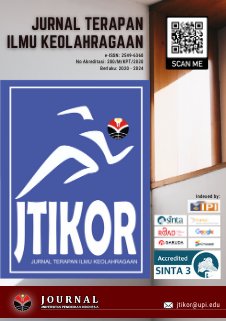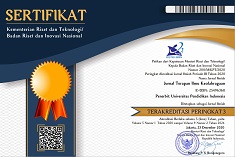Pengaruh Kinematics Feedback dan Slow Motion Feedback Terhadap Penguasaan Teknik Dasar Bola Basket Dihubungkan dengan Tingkat Kecerdasan
Abstract
Perencanaan dalam pendidikan jasmani adalah kompetensi penting bagi guru pra-jabatan yang sedang berkembang di seluruh program universitas. Dapat diketahui bahwa umpan balik membantu guru untuk menyadari tindakan mereka dalam mengajar. Efektivitas dalam kelas pendidikan jasmani lebih baik dapat dicapai dengan peningkatan penggunaan waktu dan orientasi intruksi yang benar oleh guru. Penelitian ini bertujuan untuk mengetahui pengaruh umpan balik melalui aplikasi android dengan media pembelajaran video kinematic dan video slow motion, dan untuk mengetahui adakah hubungan tingkat kecerdasan dengan penguasaan teknik dasar bola basket. Pengambilan sampel menggunakan teknik purposive sampling pada siswa SMP Nasional Bandung sebanyak 72 orang. Berdasarkan hasil analisis data menunjukkan bahwa terdapat pengaruh yang signifikan atas pemberian umpan balik yang diberikan dengan masing-masing kelompok melalui media pembelajaran video kinematic sebesar 35% dan video slow motion sebesar 31%. Hasil penelitian dari korelasi antara tingkat kecerdasan dengan keterampilan siswa dengan hasil 0,154 yang dimana nilai sig.>0,05 diperoleh informasi bahwa tidak terdapat hubungan.
Planning in physical education is an important competency for pre-service teachers who are developing throughout the university program. It can be seen that feedback helps teachers realize their actions in teaching. Effectiveness in physical education classes can be better achieved by increasing the use of time and correct instructional orientation by teachers. This study aims to determine the effect of feedback through the android application with kinematic video learning media and slow-motion video and to determine whether there is a relationship between the level of intelligence with the mastery of basic basketball techniques. Sampling used a purposive sampling technique for 72 Bandung National Junior High School students. Based on the results of data analysis shows that there is a significant influence on giving feedback given by each group through the learning media kinematic video by 35% and slow-motion video by 31%. The results of the study of the correlation between the level of intelligence with student skills with a result of 0.154 where the value of sig.> 0.05 obtained information that there is no relationship.
Keywords
Full Text:
PDFReferences
Almada-Lobo, F. (2015). The industri 4.0 revolution and the future of manufacturing execution systems (MES). Journal of Innovation Management, 3(4), 16–21
Approved, U. G. C. (2017). Abhinav International Monthly Refereed Journal of Research in Management & Technology EVOLVING WITH INTELLIGENCE QUOTIENT , EMOTIONAL INTELLIGENCE AND SPIRITUAL Abhinav International Monthly Refereed Journal of Research In. 6(6), 111–118.
Casey, A., & Jones, B. (2011). Using digital technology to enhance student engagement in physical education. Asia-Pacific Journal of Health, Sport and Physical Education, 2(2), 51–66. https://doi.org/10.1080/18377122.2011.9730351
Chaudhury, S., Garg, G., & Sharma, P. K. (2003). Digital video revisited. IETE Technical Review (Institution of Electronics and Telecommunication Engineers, India), 20(4), 309–318. https://doi.org/10.1080/02564602.2003.11417088
Dalyono. 2004. Psikologi Pendidikan. Jakarta: Rineka Cipta.
Edwards, W. H. (n.d.). Motor Learning and Control From Theory to Practice.
Goleman, D. 2002. Kecerdasan Emosional : Mengapa IQ Lebih Tinggi Daripada EQ. Alih Bahasa : T. Hermaya. Jakarta : PT. Gramedia, ISBN : 9796054086
Juniu, S. (2011). Pedagogical uses of technology in physical education. Journal of Physical Education, Recreation & Dance, 82(9), 41–49.
John McLester-Peter St.Pierre-. (n.d.).
Katsuhara Y., Fujii S., Kametani R., & Oda S. (2010). Spatiotemporal characteristics of Rhythmic,stationary basketball bouncing in skilled and unskilled players. Perceptual and Motor skills. 110: 469-478
Koekoek, J., van der Mars, H., van der Kamp, J., Walinga, W., & van Hilvoorde, I. (2018). Aligning Digital Video Technology with Game Pedagogy in Physical Education. Journal of Physical Education, Recreation and Dance, 89(1), 12–22. https://doi.org/10.1080/07303084.2017.1390504
Lubay, L. H (2015). Pembelajaran Permainan Bolabasket. Bandung
Michael, D., & Chen, S. (2006). Serious games:Games that educate, train,and inform. Stamford, CT: Thomson Course Technology PTR.
Mumtaz, S. (2000). Factors affecting teachers’ use of information and communications technology: A review of the literature. Journal of Information Technology for Teacher Education, 9, 319–342.
Palao, J. M., Hastie, P. A., Cruz, P. G., & Ortega, E. (2015). The impact of video technology on student performance in physical education. Technology, Pedagogy and Education, 24, 51–63.
Perbasi. (2012). Peraturan resmi bolabasket.[online]. Diakses: http://perbasi.or.id/peraturan-fiba/
Peter M McGinnis. (2013). Peter M.McGinnis 2013.Pot, N., Schenk, N., & Van Hilvoorde, I. (2014). School sports and identity formation: Socialisation or selection? European Journal of Sport Science, 14, 484–491.
Principles, F., Fifth, A., Richard, E., & Timothy, A. S. (n.d.). Richard-A-Schmidt_-Timothy-Donald-Lee-Motor-learning-and-performance-_-from-principles-to-applicatio.
Pyle, B., & Esslinger, K. (2014). Utilizing technology in physical education: Addressing the obstacles of integration. Delta Kappa Gamma Bulletin, 80, 35–39.
Siedentop, D., Hastie, P., & van der Mars, H. (2011). Complete guide to sport education (2nd ed.). Champaign, IL: Human Kinetics.
Sinelnikov, O. A. (2012). Using the iPad in a sport education season. Journal of Physical Education, Recreation & Dance, 83(1), 39–45. doi:10.1080/07303084.2012
Seth A, Pandy MG: A neuromusculoskeletal tracking method for estimating individualmuscle forces in humanmovement. J Biomech 2007, 40:356–366.
Sony, M. (2018). Industry 4.0 and lean management: a proposed integration model and research propositions. Production and Manufacturing
Vermeulen, J., Luyten, K., Coninx, K., & Marquardt, N. (n.d.). The Design of Slow - Motion Feedback. (Figure 1).
Tannehill, D., van der Mars, H., & MacPhail, A. (2015). Building effective physical education programs. Sudbury, MA: Jones & Bartlett.
Teasdale, T. W., & Owen, D. R. (1989). Continuing secular increases in intellgence and a stable prevalence of high intelligence levels. Intelligence, 13(3), 255–262. https://doi.org/10.1016/0160-2896(89)90021-4.
Tearle, P., & Golder, G. (2008). The use of ICT in the teaching and learning of physical education in compulsory education: How do we prepare the workforce of the future? European Journal of Teacher Education, 31, 55–72.
Thelen DG, Anderson FC, Delp SL: Generating dynamic simulations of movement using computedmuscle control. J Biomech 2003, 36:321–328.
Thelen DG, Anderson FC: Using computedmuscle control to generate forward dynamic simulations of human walking from experimental data. J Biomech 2006, 39:1107–1115.Garn, A., & Shen, B. (2015). Physical self-concept and basic psychological needs in exercise: Are there reciprocal effects? International Journal of Sport and Exercise Psychology, 13(2), 169–181.
DOI: https://doi.org/10.17509/jtikor.v5i1.24168
Refbacks
- There are currently no refbacks.
Copyright (c) 2020 Putri Kamila Nur Laila

This work is licensed under a Creative Commons Attribution-NonCommercial-ShareAlike 4.0 International License.





